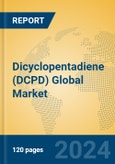Dicyclopentadiene (DCPD) is a versatile chemical intermediate used in resins and rubbers, prized for its reactivity, strength, and cost-efficiency. It excels in industrial applications, driven by demand for durable composites and adhesives. Trends focus on sustainable production, lightweight materials, and enhanced formulations.
This product will be delivered within 1-3 business days.
Market Size and Growth Forecast
The global DCPD market is estimated at USD 700 million to USD 800 million in 2025, with a CAGR of 2.5% to 3.5% from 2025 to 2030, reaching USD 800 million to USD 950 million by 2030.Regional Analysis
Asia Pacific dominates with 45-50%, growing at 3.0-4%, led by China, trending toward industrial resins. North America holds 30-35%, growing at 2.0-3%, with the U.S. focusing on polyester resins, leaning toward sustainability. Europe has 15-20%, growing at 2.0-3%, with Germany emphasizing rubber, trending toward efficiency. MEA grows at 1.5-2.5%, with 0-2% share, focusing on niche uses. South America grows at 1.0-2%, with 0-1% share, emphasizing construction.Application Analysis
Hydrocarbon resin leads with 45-50%, growing at 2.5-3.5%, driven by adhesives, with trends in durable formulations. Unsaturated polyester resin accounts for 40-45%, growing at 2.5-3.5%, focusing on composites, with trends in lightweighting. Ethylene-propylene rubber holds 4-5%, growing at 2.0-3%, with trends in automotive uses. Others grow at 1.5-2.5%, with 5-6% share.Key Market Players
- LyondellBasell: A Dutch leader crafting high-quality DCPD solutions.
- Shell: A UK titan enhancing DCPD applications.
- ZEON: A Japanese expert optimizing chemical intermediates.
- Chevron Phillips Chemical: A U.S. firm advancing DCPD production.
- YEOCHUN NCC: A South Korean innovator shaping DCPD efficiency.
- Dow: A U.S. giant delivering versatile DCPD offerings.
- ExxonMobil: A U.S. titan enhancing DCPD durability.
- Braskem: A Brazilian leader crafting sustainable DCPD solutions.
- Nova Chemicals: A Canadian firm optimizing DCPD performance.
- SIBUR (Nizhnekamskneftekhim): A Russian expert advancing DCPD uses.
- LG Chem: A South Korean titan shaping DCPD innovations.
- LOTTE Chemical: A South Korean leader enhancing DCPD applications.
- Maruzen Petrochemical: A Japanese firm crafting precise DCPD solutions.
- Sinopec: A Chinese giant delivering scalable DCPD products.
- Shandong Yuhuang: A Chinese specialist optimizing DCPD efficiency.
- Huake: A Chinese innovator advancing DCPD technologies.
- Xinjiang Tianli: A Chinese firm shaping robust DCPD offerings.
- Fushun Huaxing: A Chinese expert enhancing DCPD durability.
- Shandong Qilong: A Chinese leader crafting versatile DCPD solutions.
- Fushun Yikesi: A Chinese specialist optimizing DCPD production.
- Guangdong Xinhuayue: A Chinese firm advancing DCPD applications.
- Henghe (Nanjing): A Chinese innovator shaping DCPD efficiency.
- Ningbo Jinhai Chenguang: A Chinese expert enhancing DCPD uses.
- Zibo Luhua Hongjin New Material: A Chinese leader crafting DCPD solutions.
- Orlen: A Polish firm optimizing DCPD performance.
Porter’s Five Forces Analysis
- Threat of New Entrants: Medium. High capital barriers deter entry, but demand lowers hurdles for chemical firms.
- Threat of Substitutes: Medium. Alternative chemicals compete, yet DCPD’s cost-effectiveness sustains its edge.
- Bargaining Power of Buyers: High. Industries demand quality and cost, leveraging suppliers.
- Bargaining Power of Suppliers: Medium. Raw material suppliers hold influence, but large players diversify sourcing.
- Competitive Rivalry: High. Firms compete on production scale, pricing, and sustainability, driving advancements.
- Impact of Tariff Conflicts on Supply Chain Localization
Market Opportunities and Challenges
Opportunities
- Composite demand: Lightweighting drives growth, aligning with industrial trends.
- Adhesive growth: Packaging needs boost adoption, offering expansion.
- Sustainability focus: Eco-friendly production enhances appeal, tapping into green markets.
- Emerging markets: Industrialization in Asia Pacific fuels demand, leveraging affordability.
Challenges
- Cost volatility: Raw material fluctuations disrupt supply, challenging stability.
- Substitute competition: Other chemicals threaten share, requiring differentiation.
- Regulatory hurdles: Diverse standards raise compliance costs, slowing expansion.
- Trade disruptions: Tariffs risk supply delays, necessitating adaptive strategies.
This product will be delivered within 1-3 business days.
Table of Contents
Chapter 1 Executive SummaryChapter 2 Abbreviation and Acronyms
Chapter 3 Preface
Chapter 4 Market Landscape
Chapter 5 Market Trend Analysis
Chapter 6 Industry Chain Analysis
Chapter 7 Latest Market Dynamics
Chapter 8 Trading Analysis
Chapter 9 Historical and Forecast Dicyclopentadiene (Dcpd) Market in North America (2020-2030)
Chapter 10 Historical and Forecast Dicyclopentadiene (Dcpd) Market in South America (2020-2030)
Chapter 11 Historical and Forecast Dicyclopentadiene (Dcpd) Market in Asia & Pacific (2020-2030)
Chapter 12 Historical and Forecast Dicyclopentadiene (Dcpd) Market in Europe (2020-2030)
Chapter 13 Historical and Forecast Dicyclopentadiene (Dcpd) Market in MEA (2020-2030)
Chapter 14 Summary For Global Dicyclopentadiene (Dcpd) Market (2020-2025)
Chapter 15 Global Dicyclopentadiene (Dcpd) Market Forecast (2025-2030)
Chapter 16 Analysis of Global Key Vendors
List of Tables and Figures
Companies Mentioned
- LyondellBasell
- Shell
- ZEON
- Chevron Phillips Chemical
- YEOCHUN NCC
- Dow
- ExxonMobil
- Braskem
- Nova Chemicals
- SIBUR (Nizhnekamskneftekhim)
- LG Chem
- LOTTE Chemical
- Maruzen Petrochemical
- Sinopec
- Shandong Yuhuang
- Huake
- Xinjiang Tianli
- Fushun Huaxing
- Shandong Qilong
- Fushun Yikesi
- Guangdong Xinhuayue
- Henghe (Nanjing)
- Ningbo Jinhai Chenguang
- Zibo Luhua Hongjin New Material
- Orlen








